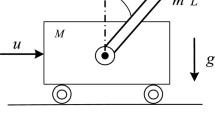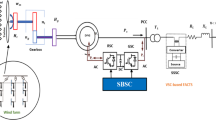Abstract
Purpose
To suppress the vibration of dumbbell-shaped spacecraft by combining distributed cooperative control (DCC) and component synthesis vibration suppression (CSVS).
Methods
The dumbbell-shaped spacecraft is divided into control sub-modules, and the dynamic model for distributed control is established according to Newton–Euler method and Lagrange’s equations of second kind; The distributed controller is designed by combining graph theory and consistency theory, and the stability of the closed-loop system is analyzed based on Lyapunov theory; CSVS + DCC method is proposed to suppress the vibration of dumbbell spacecraft. Finally, numerical simulation is used to verify the superiority and effectiveness.
Results
The large angle attitude maneuver of dumbbell spacecraft can be completed by CSVS + DCC method. Compared with bang-bang control, the stabilization time is shortened by 25.76%, and the vibration amplitude at the center of mass of the system is reduced by 53.06%.
Conclusion
The vibration of dumbbell spacecraft can be actively suppressed by CSVS + DCC active vibration suppression.













Similar content being viewed by others
Data availability
Data will be made available on request.
References
Koroteev A, Oshev YA (2015) Popov: nuclear power propulsion system for spacecraft. Therm Eng 62(13):971–980
Wang B, Liu Z, Zheng P (2022) Rigid-flexible coupling dynamic modeling and analysis of dumbbell-shaped spacecraft. Aerosp Sci Technol 107641:74–80. https://doi.org/10.1016/j.ast.2022.107641
Liu M, Cao D, Wei J (2021) Survey on equivalent continuum modeling for truss structures and their nonlinear dynamics and vibration control. J Vib Eng Technol. https://doi.org/10.1007/s42417-021-00398-4
Liu M, Cao D, Li J, Zhang X, Wei J (2022) Dynamic modeling and vibration control of a large flexible space truss. Meccanica 57:1017–1033. https://doi.org/10.1007/s11012-022-01487-8
Liu M, Cao D, Zhang X, Wei J, Zhu D (2021) Nonlinear dynamic responses of beamlike truss based on the equivalent nonlinear beam model. Int J Mech Sci 194:106197. https://doi.org/10.1016/j.ijmecsci.2020.106197
Fan L, Huang H, Sun L, Zhou K (2019) Robust attitude control for a rigid-flexiblerigid microsatellite with multiple uncertainties and input saturations. Aerosp Sci Technol 95:105443. https://doi.org/10.1016/j.ast.2019.105443
Xu S, Cui N, Fan Y, Guan Y (2018) Flexible satellite attitude maneuver via adaptive sliding mode control and active vibration suppression. AIAA J 56:4205–4212. https://doi.org/10.2514/1.J057287
Zhang K, Scorletti G, Ichchou MN, Mieyeville F (2014) Robust active vibration control of piezoelectric flexible structures using deterministic and probabilisticanalysis. J Intell Mater Syst Struct 25:665–679. https://doi.org/10.1177/1045389X13500574
Zhang K, Wu S, Wu Z (2021) Multibody dynamics and robust attitude control of a mw-level solar power satellite. Aerosp Sci Technol 111:106575. https://doi.org/10.1016/j.ast.2021.106575
Saad MS, Jamaluddin H, Mat Darus IZ (2015) Online monitoring and self-tuning control using pole placement method for active vibration control of a flexible beam. J Vib Control 21:449–460. https://doi.org/10.1177/1077546313485105
Kumar S, Matouk AE, Chaudhary H, Kant S (2021) Control and synchronization of fractional-order chaotic satellite systems using feedback and adaptive control techniques. Int J Adapt Control Signal Process 35:484–497. https://doi.org/10.1002/acs.3207
Najafizadeh Sari N, Jahanshahi H, Fakoor M (2019) Adaptive fuzzy pid control strategy for spacecraft attitude control. Int J Fuzzy Syst 21:769–781. https://doi.org/10.1007/s40815-108-0576-2
Zhou Z, Zhu F, Chen B, Xu D (2021) Barrier lyapunov function-based adaptive fuzzy attitude tracking control for rigid satellite with input delay and output constraint. J Frankl Inst 358:9110–9134. https://doi.org/10.1016/j.jfranklin.2021.09.020
Aguilar M, Cavasonza LA (2021) Ambrosi: the alpha magnetic spectrometer (ams) on the international space station: part II—results from the first seven years. Phys Rep 894:1–116
Neubert T, Østgaard N, Reglero V, Blanc E, Chanrion O, Oxborrow CA, Orr A, Tacconi M, Hartnack O, Bhanderi DD (2019) The asim mission on the international space station. Space Sci Rev 215:1–17. https://doi.org/10.1007/s40815-018-0576-2
Li X, Xiao J, Fisher JB, Baldocchi DD (2021) Ecostress estimates gross primary production with fine spatial resolution for different times of day from the international space station. Remote Sens Environ 258:112360. https://doi.org/10.1016/j.rse.2021.112360
Hu W, Ye J, Deng Z (2020) Internal resonance of a flexible beam in a spatial tethered system. J Sound Vib 475:115286. https://doi.org/10.1016/j.jsv.2020.115286
Ji X, Zhang Y, Fan G, Li M, Li X (2020) Attitude control of space solar power satellite with large range of relative motion among subsystems. Aerosp Sci Technol 100:105781. https://doi.org/10.1016/j.ast.2020.105781
Halim D, Luo X, Trivailo PM (2014) Decentralized vibration control of a multilink flexible robotic manipulator using smart piezoelectric transducers. Acta Astronaut 104:186–196. https://doi.org/10.1016/j.actaastro.2014.07.016
Sesak J, Coradetti T (1979) Decentralized control of large space structures via forced singular perturbation. In: 17th aerospace sciences meeting. https://doi.org/10.2514/6.1979-195
Luo Y, Zhang X, Zhang Y, Qu Y, Xu M, Fu K, Ye L (2018) Active vibration control of a hoop truss structure with piezoelectric bending actuators based on a fuzzy logic algorithm. Smart Mater Struct 27:085030. https://doi.org/10.1088/1361-665X/aad1b6
Hu Q, Su L, Cao Y, Zhang J (2018) Decentralized simple adaptive control for large space structures. J Sound Vib 427:95–119. https://doi.org/10.1016/j.jsv.2018.04.033
Kim N-I, Kim S, Lee J (2019) Vibration-based damage detection of planar and space trusses using differential evolution algorithm. Appl Acoust 148:308–321. https://doi.org/10.1016/j.apacoust.2018.08.032
Poplawski B, MikuÙlowski G, Mroz A, Jankowski ÙL (2018) Decentralized semi-active damping of free structural vibrations by means of structural nodes with an on/off ability to transmit moments. Mech Syst Signal Process 100:926–939. https://doi.org/10.1016/j.ymssp.2017.08.012
Zhou W, Zhang K, Wu S, Tan S, Wu Z (2022) Distributed cooperative control for vibration suppression of a flexible satellite. Aerosp Sci Technol 128:10750. https://doi.org/10.1016/j.ast.2022.107750
Wang E, Wu S, Liu Y, Wu Z, Liu X (2019) Distributed vibration control of a large solar power satellite. Astrodynamics 3:189–203. https://doi.org/10.1007/s42064-018-0046-5
Omidi E, Mahmoodi SN (2016) Vibration suppression of distributed parameter flexible structures by integral consensus control. J Sound Vib 364:1–13. https://doi.org/10.1016/j.jsv.2015.11.020
Chi J, Alahmadi D (2021) Badminton players’ trajectory under numerical calculation method. Appl Math Nonlinear Sci. https://doi.org/10.2478/amns.2021.2.00125
Wang L (2022) Data forecasting of air-conditioning load in large shopping malls based on multiple nonlinear regression. Appl Math Nonlinear Sci. https://doi.org/10.2478/amns.2022.2.0034
Majola C, Moleleki LD (2022) Symmetry analysis and exact solutions of extended Kadomtsev–Petviashvili equation in fluids. Appl Math Nonlinear Sci. https://doi.org/10.2478/amns.2021.2.00323
Abdel-Gawad HI, Belic M (2022) Similarity solutions of the surface waves equation in (2 + 1) dimensions and bifurcation. Appl Math Nonlinear Sci. https://doi.org/10.2478/amns.2022.1.00102
Zhang D, Yang L, Arbab A (2022) The uniqueness of solutions of fractional differential equations in university mathematics teaching based on the principle of compression mapping. Appl Math Nonlinear Sci. https://doi.org/10.2478/amns.2022.2.00014
Chen C, Mohamed H (2022) Optimal solution of the fractional differential equation to solve the bending performance test of corroded reinforced concrete beams under prestressed fatigue load. Appl Math Nonlinear Sci. https://doi.org/10.2478/amns.2022.2.0035
Ahn J-G, Yang H-I, Kim J-G (2020) Multipoint constraints with Lagrange multiplier for system dynamics and its reduced-order modeling. AIAA J 58:385–401. https://doi.org/10.2514/1.J058118
Acknowledgements
The authors would like to thank Dr. Tun Liu for his contribution to the computer implementation of the initial computer code for the co-rotational finite element model.
Author information
Authors and Affiliations
Corresponding author
Ethics declarations
Conflict of interest
The authors declare that they have no conflict of interest.
Additional information
Publisher's Note
Springer Nature remains neutral with regard to jurisdictional claims in published maps and institutional affiliations.
Appendices
Appendix 1
Equation (6), the simplification process applies the vector first relation as follows:
When \({\varvec{r = \rho }}\), the vector first relation was transformed into:
Appendix 2
Equation (6), the second relation of vector applied in simplification process is as follows:
Appendix 3
Rights and permissions
Springer Nature or its licensor (e.g. a society or other partner) holds exclusive rights to this article under a publishing agreement with the author(s) or other rightsholder(s); author self-archiving of the accepted manuscript version of this article is solely governed by the terms of such publishing agreement and applicable law.
About this article
Cite this article
Ai, Q., Wang, Q., Li, J. et al. Research on Dynamic Modeling and Distributed Cooperative Control Method of Dumbbell-Shaped Spacecraft. J. Vib. Eng. Technol. 12, 3033–3049 (2024). https://doi.org/10.1007/s42417-023-01031-2
Received:
Revised:
Accepted:
Published:
Issue Date:
DOI: https://doi.org/10.1007/s42417-023-01031-2




